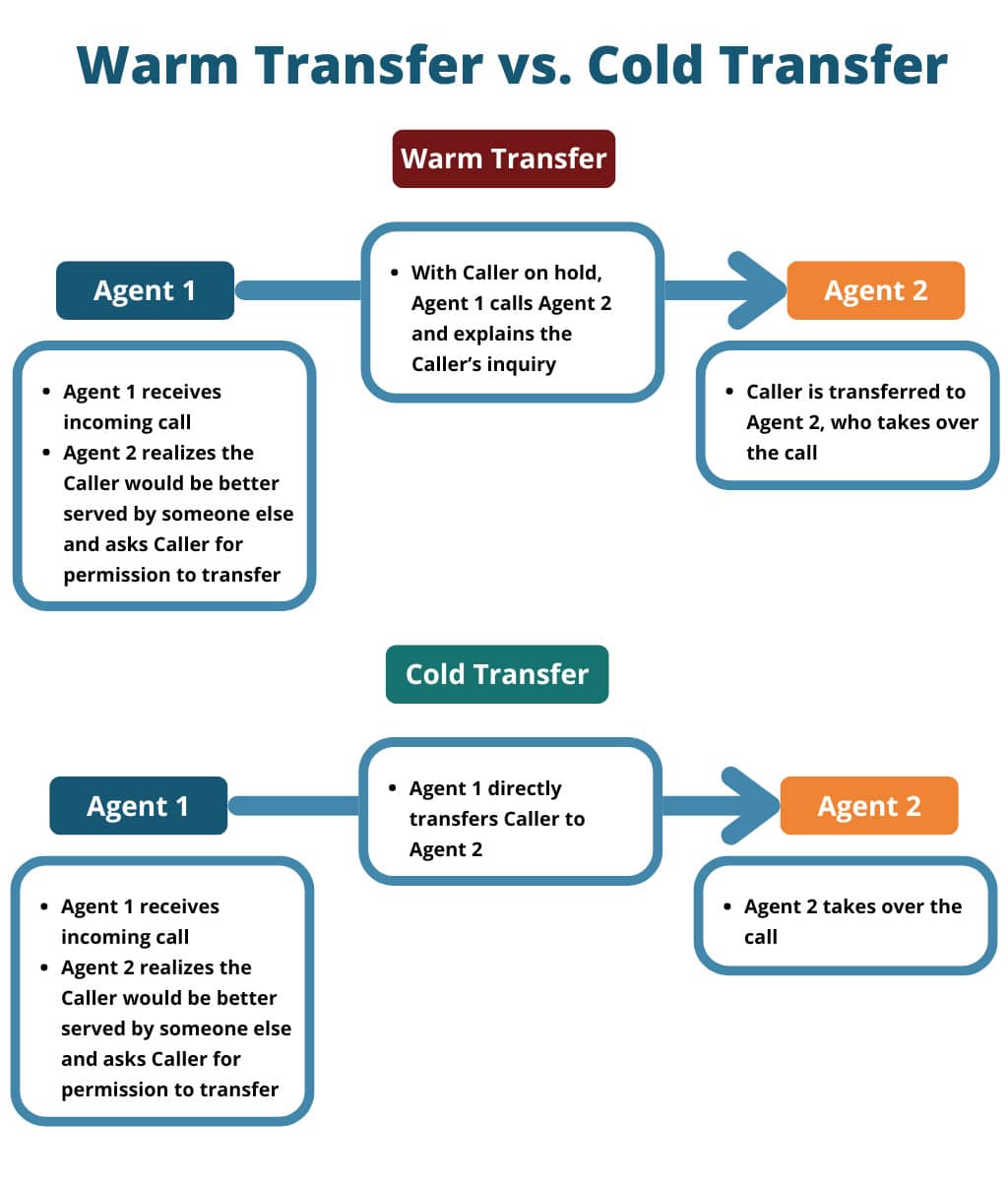Warm vs. Cold Transfer: The Difference and Why It Matters
Reading Time: 9 minutes
Table of Contents
- Warm transfer vs cold transfer: what’s the difference?
- Choosing warm vs. cold transfer
- Weighing warm transfers vs. cold transfers: Pros and cons
- Why use a warm transfer
- Alternatives when warm transfer isn’t an option
- Best call transfer practices for businesses
- Partner with ROI for reliable inbound call center solutions
Introduction
Mastering call transfers begins with learning the difference between warm transfers vs. cold transfers and when to opt for each one. Both methods have their place in call center operations, but deciding which to use an make or break a customer interaction. In this blog, we’ll explore both types of call transfers and how your business can leverage them to create better customer experiences.
Key takeaways
- Difference between warm transfer and cold transfer: A warm transfer happens when an agent briefs the next agent about the customer’s query before initiating the transfer, providing a smoother handoff. Agents perform a cold transfer by simply forwarding the call to the next agent without providing context.
- When to use warm vs. cold transfer: Warm transfers are well-suited to more complex customer queries or situations where emotions are running high. Cold transfers work when there isn’t much to share with the next agent or the customer has simply reached the wrong department.
- Advantages and disadvantages: Warm transfers can help enhance the customer experience by making things less repetitive, while also boosting efficiency for call centers. However, they also require a small time investment upfront. Cold transfers take little time or effort to accomplish, but when used inappropriately, can be frustrating for customers and negatively affect efficiency in the long run.
Warm transfer vs cold transfer: what’s the difference?
You can classify call transfers into two types: warm transfers and cold transfers. Both transfers entail sending active calls to another number or agent, yet they impact your customers differently.

What is a warm transfer?
A warm transfer occurs when the original receiver of the call provides information to the next agent before completing the transfer. The information shared includes relevant details that can help the next agent provide better support, such as the customer’s account number and specific concern. While this transpires, the caller is typically placed on hold.
Warm call transfers can foster a smoother transition by giving the next agent the details they need to provide prompt service. It also saves time that you might spend on repeating the issue. In addition, a warm transfer helps the agent exhibit a friendlier, more personal approach, making customers feel valued.
What is a cold transfer?
Unlike warm transfers, cold transfers don’t include an initial briefing or transfer of information. Instead, the caller is transferred to the next team member who will handle the call. If the agent cannot take the call, the caller may get sent to voicemail.
Businesses can leverage interactive voice response (IVR) systems to facilitate customer-initiated call transfers. These systems are beneficial for companies with several departments catering to customer issues.
Choosing warm vs. cold transfer
Although warm transfers seem the better choice, this is not always the case. Learning when to use warm vs. cold transfer can help businesses serve their customers better.
When should you warm transfer?
Warm transfers can improve customer experience by eliminating customers’ need to repeat themselves and ensuring customers won’t get transferred to the wrong extension.
Situations warranting a warm transfer include:
- Emotional calls
- Escalation calls
- Concerns involving sensitive subject matter
- Complex customer issues
Calls related to specific customer accounts, like product returns or account issues
When working with prospects, warm transfers can help show callers that you value their interest by providing solutions and suggestions during sales calls.
When should you cold transfer?
Cold transfers are appropriate for simple customer concerns that don’t require background information. For example, if your customer inquiries about available payment options, you can route them directly to a billing agent to reduce wait times. These transfers are also the best approach to addressing calls out of an agent’s wheelhouse when customers call the wrong department.
The key to reducing friction in cold transfers is good communication. Agents should inform callers about the transfer and provide them with alternative options in case they experience trouble with the transfer.
Weighing warm transfers vs. cold transfers: Pros and cons

Consider these pros and cons when deciding to use warm vs. cold transfer.
Warm transfer pros
- Agents are better prepared to handle customer concerns
- Calls are personalized based on customer needs
- It eliminates the need to repeat information
Warm transfer cons
- Time-consuming for agents
- Callers are put on hold for a longer time
Cold transfer pros
- Facilitates quicker transfers to address customer concerns
- Provides after-hours and round-the-clock support
- Offers self-service options through IVR systems
Cold transfer cons
- May increase caller dissatisfaction when calls are not answered immediately
- It acts as a “reset” button, and the customer must repeat their concerns
Cold transfer example
Cold transfers definitely have their place in a call center. The best time to use a cold transfer is in situations where no one needs to be introduced or announced.
For instance, if you, as a help desk agent, receive an incoming call and the caller says that they want to learn more about your product or service, that means that the call has been sent to you in error. The caller would be better served in this situation by speaking to the sales team. Since you and the caller haven’t shared any important qualifying or contextualizing information this early in the conversation, the sales team doesn’t need to be brought up to speed on anything, so this caller can easily by cold transferred to the sales team, freeing up your line for calls better suited to you and your department.
Warm transfer example
Warm transfers are best suited to situations where further context and introductions would be more helpful and efficient. If you and the caller have shared more than introductory information and that info could quickly catch up the agent receiving your transfer, then a warm transfer is a good choice.
As an example, suppose that you, a receptionist at a bank, receive a call from a customer with a complex problem with their account. As a receptionist, you likely don’t have access to some of the systems needed to solve the problem, or the authorization and specialized training that such a task demands.
However, you understand enough of the problem that the customer is describing to know which person or department is qualified to help. After listening to the customer and taking thorough notes, you decide to perform a warm transfer, letting the customer know that you’ll be transferring them to another department that can help, and briefly place them on hold. With the customer on one line, you dial the appropriate employee or department on another and explain the problem to the best of your ability to team member who answers. Once the appropriate team member is up to speed with the problem, you can transfer the customer.
Why use a warm transfer
One major reason that a warm transfer is so beneficial is that it’s an overall more welcoming experience for customers. If a customer’s first point of contact isn’t able to resolve the subject of the call, it feels much better, from a customer standpoint, to be sent to someone who has their account information available and an understanding of the problem than it feels to be handed off to the next available agent who asks all of the same questions.
Warm transferring a caller also makes for a better agent experience. Imagine, as an agent, receiving a call out of the blue. You’re suddenly speaking to a frustrated customer who is quickly losing their patience because they’ve already spoken to another agent who couldn’t help them and now they have to start from the beginning. The caller is no closer to resolving the complaint they called about. Calls in that scenario are often quite tense, and can be stressful for agents to navigate.
Outside of the emotional experience of a warm transfer, there’s also no denying that a well- executed warm transfer is more efficient. The “starting from scratch” moment of an inappropriate cold transfer is not just frustrating for all involved, it’s a waste of everyone’s time and effort, including the customer. The lost time retreading the same questions and troubleshooting with multiple agents really adds up and ultimately loses your company money.
ROI CX Solutions can provide you with a dedicated team of highly-trained call center professionals, equipped to perform excellent warm transfers. Get a free quote from ROI CX solutions today!
Alternatives when warm transfer isn’t an option

While effective, there are times when a warm transfer might not be easy or feasible. In those situations, an automated system can provide a couple of “next-best” options to get the customer to the right place.
1. Use call routing to transfer to another agent
In some situations, an agent might receive a call and realize that the problem is something that requires someone else’s skill set or clearance, but then find that a warm transfer isn’t currently doable, either because they aren’t sure who the best option is, or because the best agent for the job is currently occupied.
In those cases, the original agent can let the caller know they are about to be transferred, and the agent can route the call automatically to another agent based on a variety of different criteria. These call routing systems are usually flexible enough to customize, either sending calls directly to particular agents or departments based on their area of expertise, or else procedurally routing calls based on the customer’s profile and main complaint. Calls can be routed using:
- Longest idle routing
- Fixed order routing
- Round robin-style routing
- Skills-based routing
- Location-based routing
- etc.
By automating your call routing, you can ensure that the incoming calls have a greater chance of reaching the right agent, and your customers don’t get stuck leaving a voicemail.
2. Use call routing to transfer to another phone
Using similar tech and call routing software as Option 1, an agent can automatically transfer the call to another appropriate phone or phone system, even one outside of the primary call center location. This is particularly helpful during times of high call volume, when the customer needs help from an outside partner, or when the primary call center is outside of normal business hours.
Best call transfer practices for businesses

In the warm transfer vs. cold transfer debate, no single solution fits all situations. However, these practices can help your business identify which call transfer approach provides the best customer experience, creating better relationships in the long run.
1. Train your agents
Review your current inbound processes, and identify areas of improvement. By investing in agent training, you can ensure that your team members know how to properly conduct call transfers and utilize the features of your phone systems. Consider educating your agents about phone etiquette and professionalism to foster better customer communication.
2. Always ask permission
Always treat callers with respect by giving them an explanation for the transfer, and asking if they are willing to speak to someone else. This keeps the caller in the loop of your thought process, makes the handoff a smoother process, and gives the customer validation and a greater sense of control over the situation.
3. Keep customers informed
Ensure that callers know before you transfer them to another call, and always ask for permission. Thoroughly explain why the transfer is necessary and let them know what to expect. Communicate to your customers that you value their time and patience and are focused on helping them resolve their concerns in the most convenient way possible.
4. Take accountability
If your customer has been put on hold longer than expected, apologize and ensure they know you value their time. Likewise, if you can’t resolve their issue on the first call and transfer them to a more suitable agent, reassure them that you’ll attend to their concern.
5. Establish clear policies
It’s crucial to have consistent and clear policies that outline when agents should use a warm transfer vs. cold transfer. These guidelines can empower your agents to make better decisions and ensure consistent caller experiences.
6. Consider outsourcing
Cold transferring a call is typically the last resort, reserved for times when businesses face a surge of calls and are trying to attend to many customers. However, when not done right, this can damage customer relationships.
Growing businesses can leverage the technology and expertise of third-party companies like ROI CX Solutions if they don’t have the in-house capacity to handle calls or want to invest in improving customer experience in the long run.
Partner with ROI for reliable inbound call center solutions
With the quality of customer experience at stake, deciding whether to opt for warm vs. cold transfers can be challenging. Let us handle the work for you.
At ROI CX Solutions, we provide businesses with world-class customer service with cutting edge call center solutions that help improve customer experience and satisfaction. Reach out to learn more about how we can serve you, or request a free quote today!






